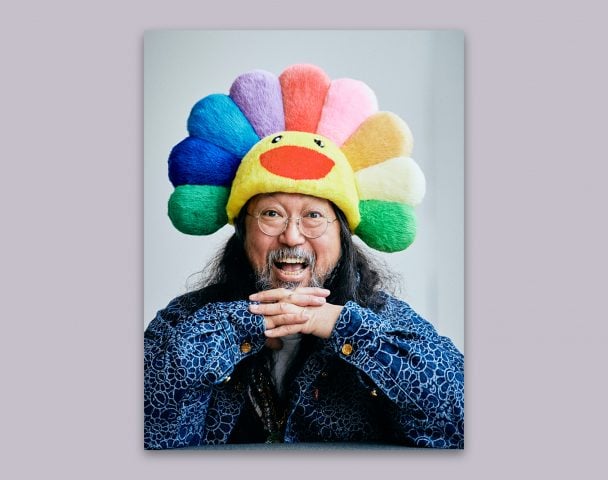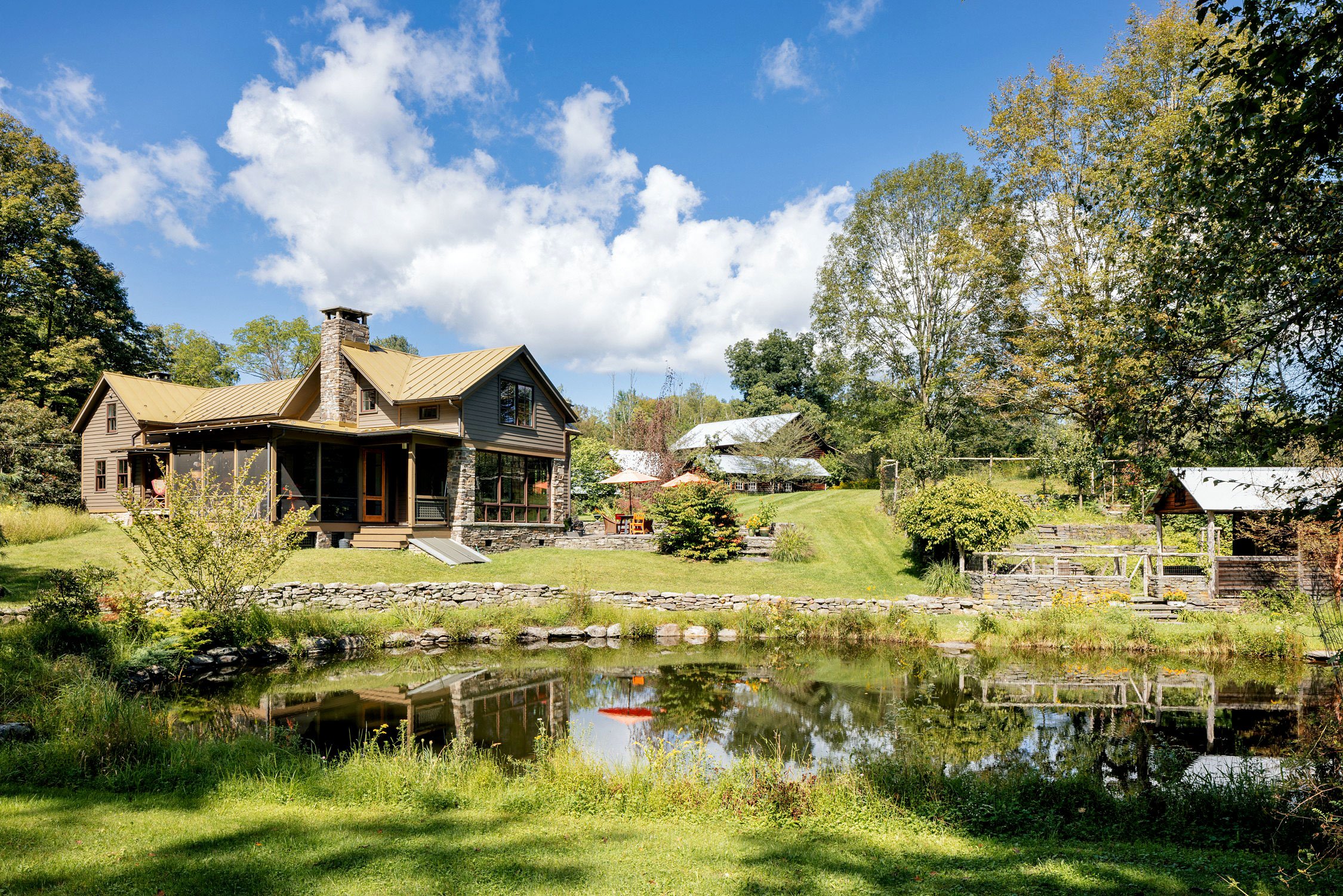Art World
Is the ‘Luna Luna’ Art-Themed Amusement Park Amusing?
No need to buckle up! But there's joy to be found at this fun fair exhibition, courtesy of artists like Keith Haring, Roy Lichtenstein, and Kenny Scharf.

When I first heard about Luna Luna, the grand resurrection of the world’s pioneering art amusement park, I had certain expectations. I took for granted that I would actually be riding the rides at the exhibition, which opened at the Shed in New York earlier this week. I imagined myself spinning gleefully on Keith Haring’s carousel. The exhibition’s promise was tantalizing—sitting on works by the titans of contemporary art in the context of a carnival, the most unserious of settings—but, at Luna Luna, you can’t ride the rides. Probably a liability issue.
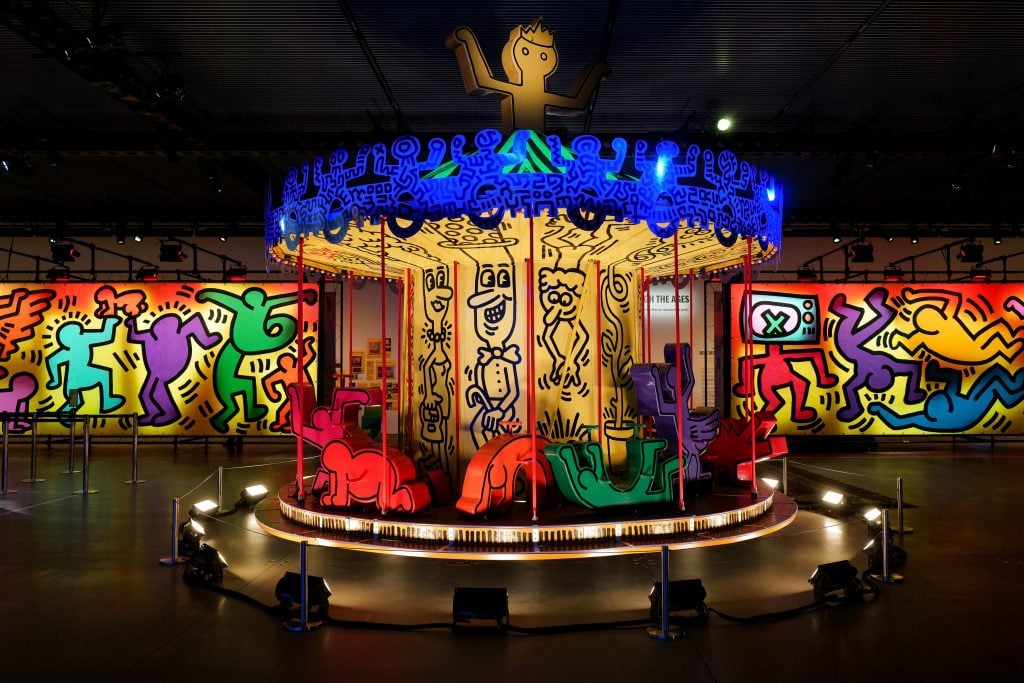
Keith Haring’s carousel is the centerpiece to Luna Luna. Photo: Madison McGraw/ BFA
Perhaps they’re at risk of falling apart? After all, they were abandoned for more than three decades in shipping containers in the Texas desert. The original Luna Luna was the brainchild of Austrian artist André Heller. Premiering in Hamburg, Germany in 1987, it was a functioning amusement park that boasted 33 attractions by some of the most iconic artists of the era, including a ferris wheel by Jean-Michel Basquiat and a Kenny Scharf wave swinger. After only summer of exhibition, the park faded into obscurity, all but forgotten. The project was reincarnated after Drake backed its restoration leading to a Los Angeles reprisal earlier this year.
“Drake spent $100 million on this show,” said Jeffery Deitch when I bumped into him at the preview. “This is the first stage of the exhibition, the next will include current artists and musicians.”
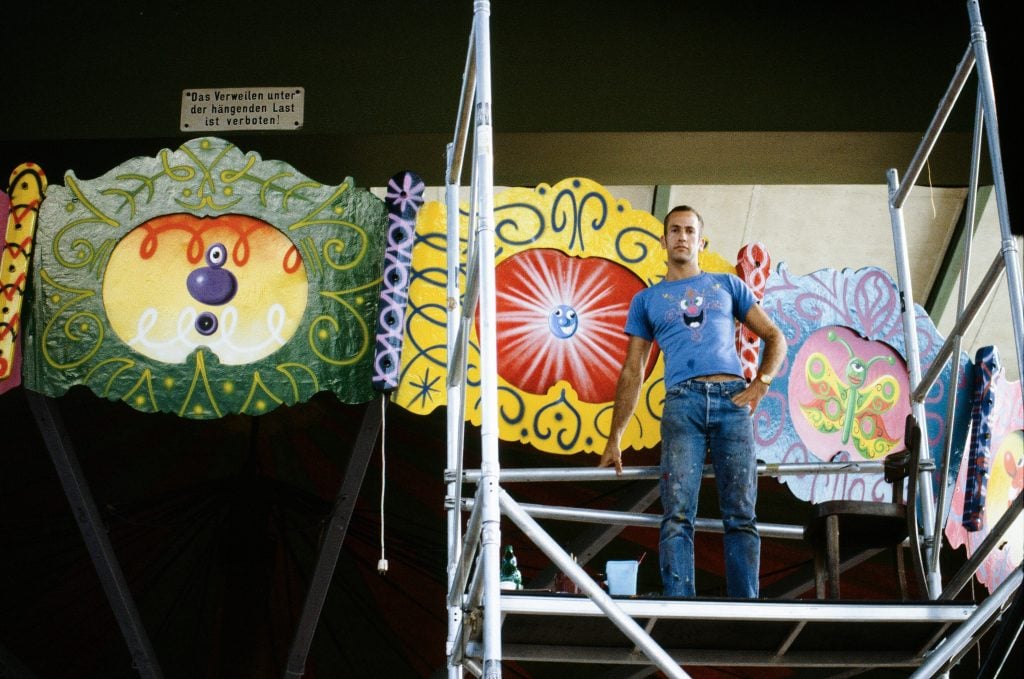
Kenny Scharf with his painted chair swing ride. © Kenny Scharf. Licensed by Artestar, New York. Photo: © Sabina Sarnitz. Courtesy Luna Luna, LLC
The New York exhibition runs until January 5, 2025. The standard entry prices are lofty: $44 for an adult on a weekday, rising to $64 at the weekend and $35 for a child. For that chunk of change, you can get lost in Lichtenstein’s glass maze, take the perfect selfie in Dalí’s dome of mirrors, and get teased by entertainers who patrol the indoor grounds with naughty puppets—prepare to be stalked by butterflies and spooked by hobgoblins.
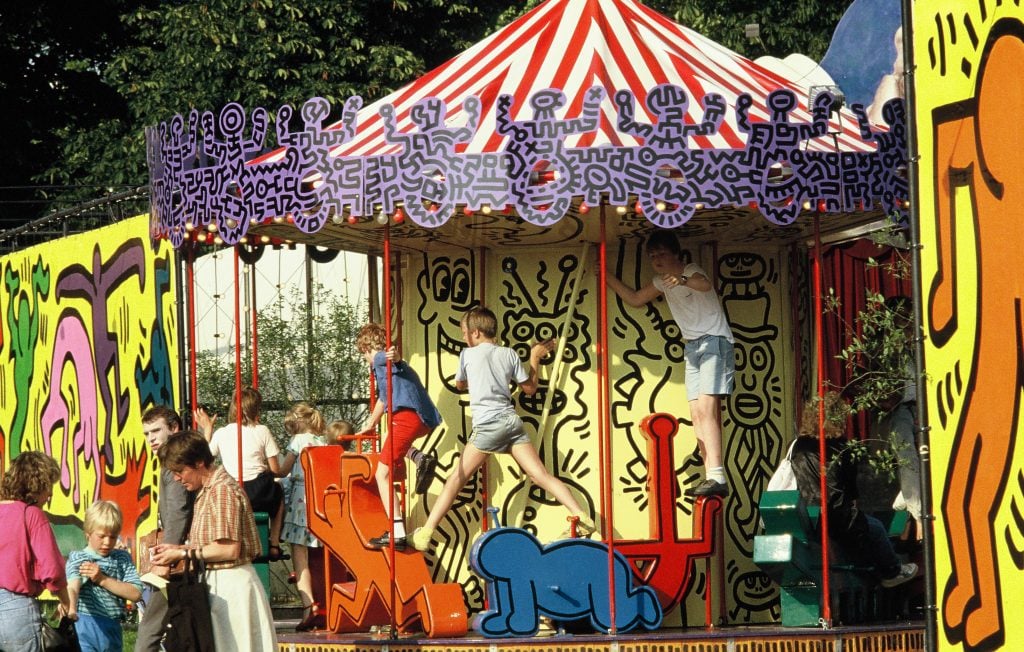
Visitors ride Keith Haring’s painted carousel. Luna Luna, Hamburg, Germany, 1987. ©
Keith Haring Foundation/licensed by Artestar, New York. Photo: © Sabina Sarnitz.
Courtesy Luna Luna, LLC
There are a lot of wall texts at Luna Luna. A timeline of the park’s mythology that attempts to connect it with the history of Modernism stretches across one wall. The didactic text includes a montage from the original 1987 carnival showcasing snapshots of rowdy children clamoring over Haring’s carousel. The late Pop artist’s joyfully garish carousel is now center-stage. Alas, it is shielded from the public by a brigade of metal stanchions.
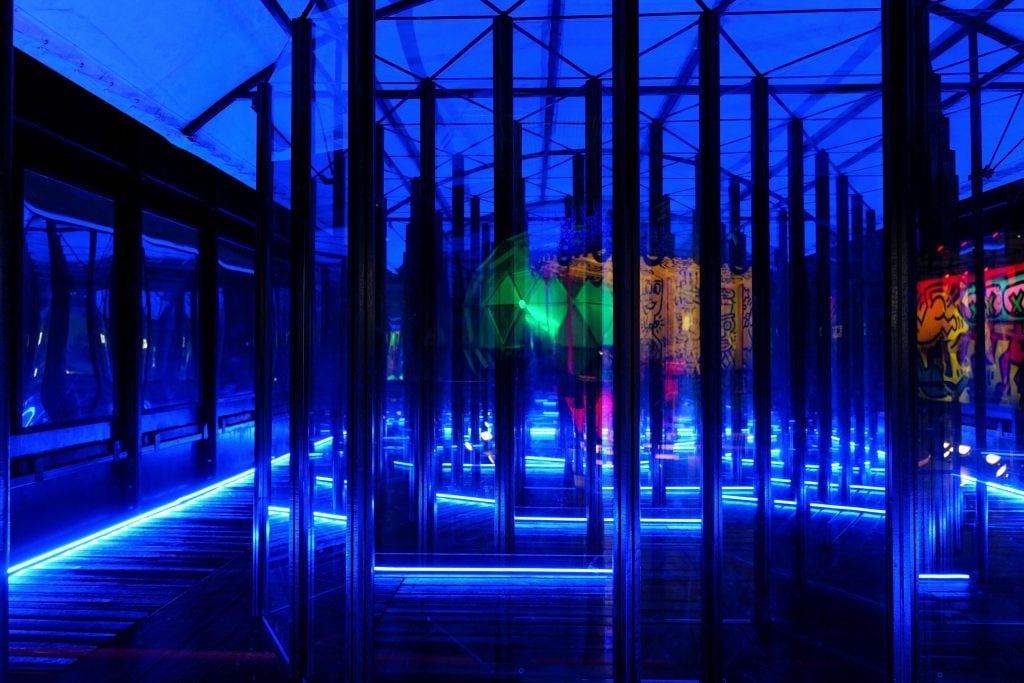
Roy Lichtenstein’s glass labyrinth at Luna Luna at The Shed. Photo: Madison McGraw/ BFA
The original Luna Luna hosted what can best be described as a fart orchestra, the Palace of the Wind. Performers would pass gas into microphones accompanied by live classical music played by violins. Sadly, at the Shed, flatulent fiddlers are nowhere to be found. What remains is its proscenium arch. Created by Austrian caricaturist Manfred Deix, it depicts an absurd scene with gale force farts, windswept hair, and buttcrack saxophonists.
At times, Luna Luna felt more like a post-amusement park. It was hard to accept that these rides, once teeming with life, were now verboten. The exhibit’s conceit was its glaring absence of frivolity, its lifelessness overwhelming. Disappointed, I dragged my feet to the next hall, drawn by the hum of ambient music and a glimpse of Basquiat’s white ferris wheel, tagged with his signature graffiti illustrations. I then heard a booming announcement: “I now proclaim you wife and wife!” This voice led me to a raucous wedding chapel.
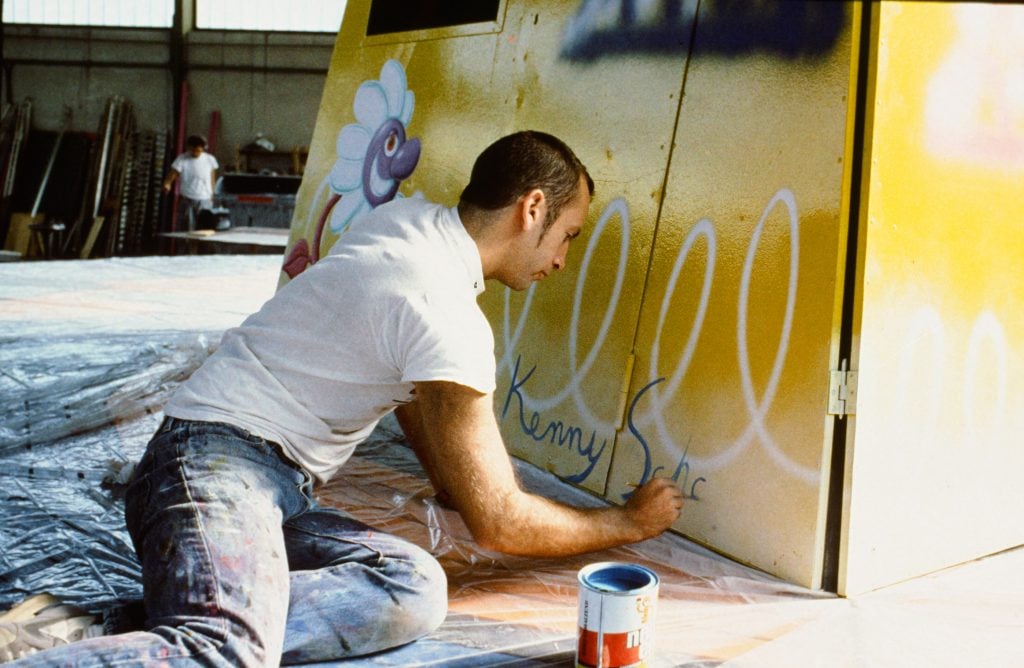
Kenny Scharf signs his painted chair swing ride. © Kenny Scharf. Licensed by Artestar, New York. Photo: © Sabina Sarnitz. Courtesy Luna Luna, LLC
The founder, Heller, designed a wedding chapel where anyone could marry anyone, or anything, a radical political act in the ‘80s. Reconstructed at the Shed, the chapel’s arched entryway depicts two androgynous characters right out of Bob Fosse’s Cabaret, holding an illuminated heart between them. My friends and l waited our turn for our fourway polyamorous nuptials. We were given pool noodle crowns with mesh veils, and frisbee rings to exchange as wedding bands. After a ceremony involving megaphones, a musical triangle, and a water gun, the officiant’s mute assistant snapped a Polaroid of us and glued it to an extremely official-looking marriage certificate. The fine print read: “to divorce, rip this up.”
As we stepped out of the chapel, giddy with its absurdity, a giant soft orange monster head plopped on the floor like a beanbag caught my eye. The monster had star button eyes, a bulbous pink nose with a hypnotic spiral sewn through it, floppy ears like a jester’s hat, and a dopey smile with only three little teeth. As I walked up to the creature, it growled at me! Its blue lips wriggled as it grumbled. Suddenly the goblin head sprouted two human-sized legs, and scurried off into the distance, leaving a crowd of cackling onlookers in its wake.

Roy Lichtenstein, Luna Luna Pavilion. Hamburg, Germany, 1987. © Estate of Roy Lichtenstein, 1987, all rights reserved. Photo: © Sabina Sarnitz. Courtesy Luna Luna, LLC
And then, all at once, every attraction in the main hall sprung to life. The accordion squall of a carnie tune blasted through the speakers and the Basquiat ferris wheel started spinning, a string of bright lights arranged behind it blinking in sequence. Scharf’s wave swinger, graffitied with playful geometric shapes and his signature cartoons, began twirling as its chairs took flight. Surrealist Austrian artist Arik Brauer’s carousel whirled like a zoetrope, telling the story of its eight seats designed like oneiric characters from a fairy tale—among them a mermaid, a butterfly, and an anthropomorphic four-legged hand with hooves.
Performers came rushing out through French artist Sonia Delaunay’s orphic Luna Luna archway, gripping long poles with felt butterflies attached to their ends, swaying over the heads of the crowd. One singled out an unwitting audience member, skipping up to her and handing her a massive felt sunflower. The recipient was artist Sasha Gordon, a bride fresh from our fourway wedding who was recently signed by David Zwirner as the youngest artist on their roster. Gordon extended her arms, holding the flower high up above her head with both hands, and all the butterflies swarmed her, surrounding her in a flurry of sway poles and color, blessing her as their chosen one. In a flash, the same performer who handed her the flower jumped and snatched it out of her hands, and fled the scene. All the butterflies skittered away in pursuit. Gordon frowned. “That was mean,” she huffed.

Massive puppets by Puerto Rican art collective Poncili Creación interacted with attendees throughout the night. Photo: Brian Ferry, Courtesy Luna Luna LLC
The impish puppets and performers are the beating heart of Luna Luna. They’re the inventions of Poncili Creación, a Puerto Rican art collective helmed by twin brothers Efrain and Pablo Del Hierro. When Efrain Del Hierro was approached to enliven the show, he knew he had to “bring some fucking imagination into it.”
“I built all these characters to awaken the dead soul of the people,” Del Hierro explained. One of these characters was a purple elephant, adorned with twinkling stars, that marched through the crowd, at one point stopping to defecate a fabric carrot. “All these creatures are designed to evoke a different kind of feeling, not necessarily a good one or a bad one, but a little shake to what people are used to feeling. They are meant to interact and live in the people’s space, to be with the people.”

Salvador Dalí’s Dalídom is a mirrored funhouse at Luna Luna. Photo: Madison McGraw/ BFA
I continued my exploration of the exhibit with renewed curiosity. My next stop was the Dalídom, a pavilion created by the legendary Spanish surrealist Salvador Dalí. Its exterior featured paintings of trapeze dancers, posed like runway models in spiked leotards, with fish tails for feet. The figures were posed in a galactic desert landscape, with thorny spinning tops behind them. Moving past the facade, I entered the pavilion to find a massive mirrored dome. The space was like a fractal mirrored fun house where you can trip out on neon lights and infinite reflections while Gregorian chants by Blue Chip Orchestra ring out of the speakers. Some groups snapped selfies while others huddled, discreetly snorting powders to heighten the experience of this temple of hallucination.
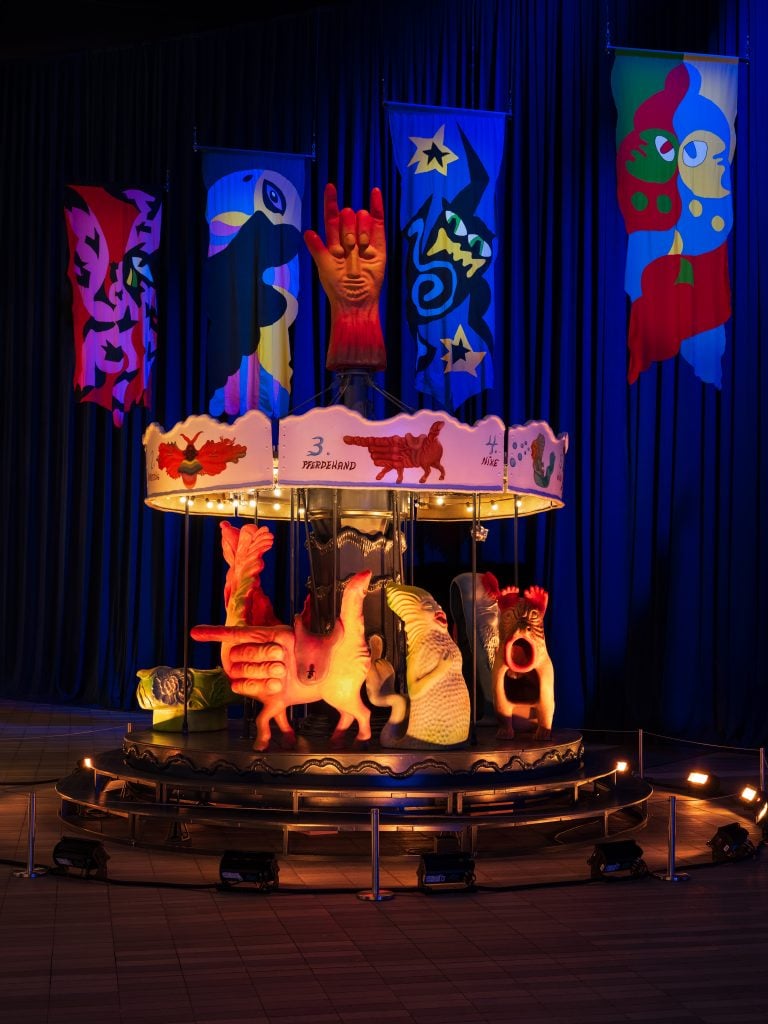
Monika Gilsing’s Wind Images hang over Arik Brauer’s carousel of Photo: Brian Ferry, Courtesy Luna Luna LLC
A favorite attraction was the colorful flags depicting lovers and goblins hung around the perimeter of the hall by German artist Monika Gilsing. I stopped to take them in on my way to David Hockney’s Enchanted Tree, which stood as the park’s cylindrical striped big top circus tent. I entered the pavilion to discover another deconstructed cylinder within, this one composed of alternating wooden panels you could walk between. It was just a few minutes before closing, and there was hardly anyone inside. From the corner of my eye, I noticed a handsome man watching me, slowly weaving between the wooden panels as I was, a sultry pace to our steps. We were the last two people there. When I dipped behind a wooden panel, he did too. When I paused to look, he paused to look. “I’m being cruised at Luna Luna,” I thought, as my pulse quickened. I stood and shifted my weight to one side, and he did the same. It was then that I noticed he was mimicking me, a human mirror. To test my theory, I held my arms akimbo, and he did too. Then, to shatter my cruising fantasy, I waved my arms in the air like an inflatable tube man outside a car dealership, and he did the same. I guffawed in delight and embarrassment, waving goodbye before scampering out of the pavilion. Luna Luna had won me over.
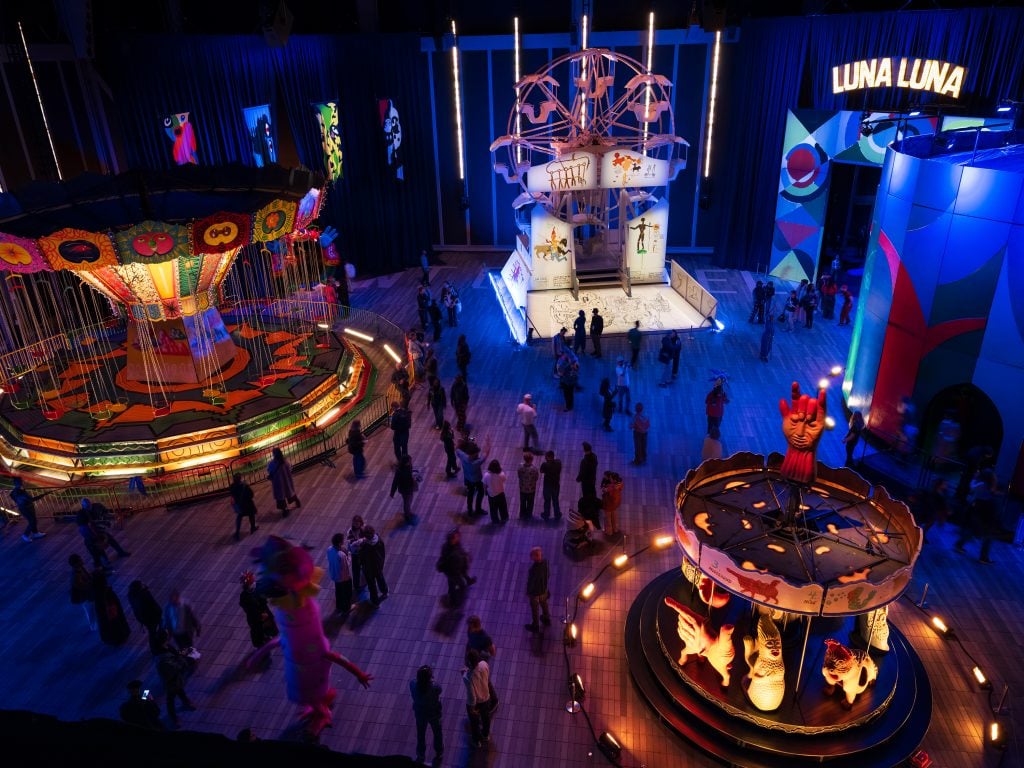
Photo: Brian Ferry, Courtesy Luna Luna LLC
Just before closing, I snuck a quick peek at PonciliLand, a playground designed by Poncili Creación. The space is filled with geometric pillows and absurdly anthropomorphic plushies, ovals with teeth and vinyl hands with faces painted on them. I never made it to Lichtenstein’s glass labyrinth, where attendees can wind through the maze to a soundtrack composed by Philip Glass. I did, however, make it to the gift shop.
Original posters by artists from the 1987 iteration of the amusement park were for sale, for prices ranging from $350 to $1,500. The shop also offered original deadstock T-shirts with designs by Haring and other artists involved, rescued from the same shipping containers as the rides. I bought a plushie of a monkey’s butt, a motif taken from the backside of Basquiat’s ferris wheel.
While it is disappointing that you can’t get on any of the rides, through the mischief of its performers and the whimsy of its installations, the exhibit ultimately thrills as a reincarnation of an art amusement park. While Luna Luna could probably stand to add a carnival game with winnable prizes, I left The Shed beaming with glee, inspired by beauty and by play, just as I have after a day out at Six Flags or Coney Island.
“They just wanted people to have fun,” said Del Hierro of Luna Luna’s founding artists. “This amazing thing was meant to be a machine of imagination and it still is.”
“Luna Luna” is on view at the Shed, 545 West 30th Street, between 10th and 11th Avenues, New York, New York, November 20, 2024–January 5, 2025. The hours are Tuesday–Thursday, 12 p.m.–8 p.m.; Friday, 12 p.m.–9 p.m.; Saturday, 10 a.m.–9 p.m.; and Sunday, 10 a.m.–8 p.m. Closed Monday.


